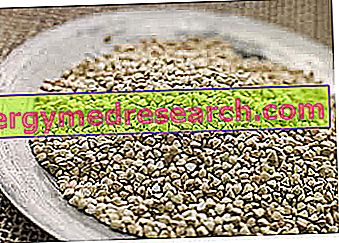Quinoa
Quinoa is an annual cycle herbaceous plant belonging to the Amaranthaceae family (the same as beet); the binomial nomenclature of quinoa is Chenopodium quinoa (Class. Willd.).

Due to nutritional affinities and commercial use, it is considered a "cereal"; however, not belonging to the Poaceae (Graminaceae) family, quinoa is often included in the group of pseudo-cereals (similar to amaranth and buckwheat).
The quinoa plant reaches a height of 2m and produces small white or yellowish seeds, of circular and flattened shape, organized in small clusters (1.5-2.0mm in diameter, similar to lentils but as big as millet). After cooking, these seeds represent the so-called edible portion of the vegetable and are characterized by a typically acrid taste.
Quinoa can be consumed whole, in the form of whole grain flours or sprouted seeds (which further increase its nutritional value). Not containing gluten, it would be suitable for celiacs; however it is always good to consider the presence of any contamination in the production cycle.
In its natural state, the quinoa seed is covered by a thin veil of saponins with a surfactant action. These give the freshly picked quinoa a typically bitter taste, as well as a potentially toxic action towards the intestine and the respiratory tract. Obviously, this feature vanishes totally with washing.
In the southern hemisphere, quinoa sowing occurs between the end of summer and the beginning of autumn, while harvesting takes place in December.
Light Salted Cake with Mushrooms and Quinoa - Without Eggs and Butter
X Problems with video playback? Reload from YouTube Go to Video Page Go to Video Recipes Section Watch the video on youtubeQuinoa flour
Quinoa flour is a gray-green powder obtained by grinding Chenopodium quinoa seeds. These, which need OBLIGATORY washing to be deprived of saponins, are sold with a fibrous coating and give rise to an integral type of flour.
Despite being gluten-free, quinoa is often used in the baking of low products (similar to piadine), sometimes leavened by means of chemical agents, or mixed with wheat flours in relation: quinoa 1 / wheat 2 or 3. The flour of quinoa also lends itself to dry pastry processing, such as biscuits; there are also various "farinata" recipes and some preparations for feeding the post-weaning infant.
Quinoa and quinoa flour are products that, like amaranth and amaranth flour, have fully supported the power of pre-Columbian civilizations. Currently, these foods are widespread especially among lovers of natural, organic and vegan foods, as well as macrobiotics. Due to its nutritional characteristics, quinoa flour and quinoa are often classified as super foods.
Quinoa flour has an energy density similar to that of cereals; most calories therefore derive from complex carbohydrates, although the Glycemic Index is rather moderate.
It has a significant protein intake (14%), characterized by the high concentration of the amino acid lysine (medium-high Biological Value, depending on the bibliographical source); however, remember that this nutrient is even more abundant in most legumes, as well as in wild rice, buckwheat and oats.
Quinoa flour provides excellent concentrations of dietary fiber, phosphorus, magnesium, iron and calcium.
Quinoa flour contains significant concentrations of betaine, a molecule still under study which, while it appears to perform enzymatic-like actions, on the other (at high doses) has not yet been defined as totally harmless for the pregnant woman .



